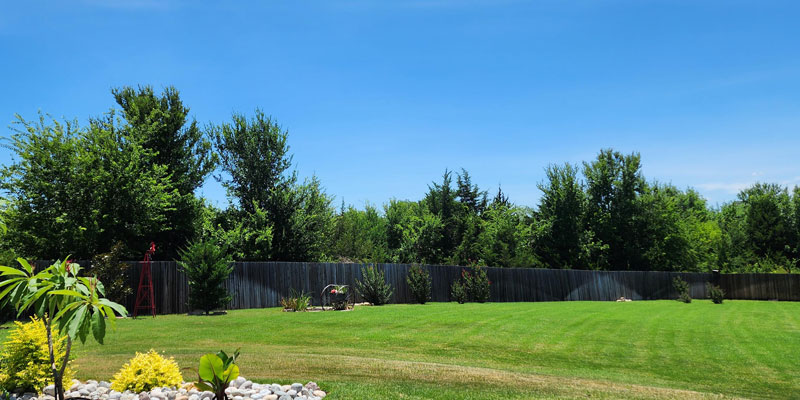Q&A – Ask Neil: July 11, 2024
(Please read these instructions carefully.)
Before you post your question, please look at recent issues to see if someone else has already asked it. You might find your answer there.
How to submit your question…
(Note: You may need to allow a pop-up window to come up in order to get the link for sending your photo(s). If you have already submitted your question and didn’t see the pop-up window, please click here.)
• Click the link provided below to post your question. After you submit your question, a new window will pop up giving you the address to which you can e-mail a SHARP, HIGH-RESOLUTION PHOTO to accompany your question. Please DO NOT SEND THUMBNAIL PHOTOS in case I need to zoom in to see things.
• Click here to post your question.
• Please ONLY POST YOUR QUESTION ONE TIME. We can only accept a set number of questions each week, and when we get duplicates it costs other people their chances.
• One question per reader, please.
• Please use this only for posting questions – not for standard emails.
• Watch for your answer in the following week’s e-gardens.
• I choose those of greatest general interest. For example, plant IDs seldom make the cut.
• I must have your first name or initials.
• I must have your city or county. (Texas is a very large state.)
QUESTION 1
WHY DID MY MUMS’ BUDS SHRIVEL?
Question: What happened to my mums? They were covered with buds. Some developed normally, but the majority shriveled up before they could open. Maxine K., Tomball.
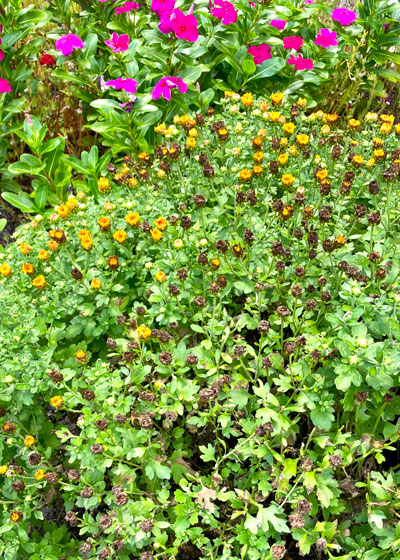
Answer: I must be intuitive. I need to buy a lottery ticket! Read my story on plants you don’t want to allow to come into bloom. It’s in this issue, and mums are at the end of that story. Garden mums (as opposed to florist mums) will try to produce buds and blooms in early spring, but days will get longer and the flowering process will stall out by late spring. The buds run into what growers call “heat delay.” That’s the time at which you want to trim them off, cutting back into totally vegetative growth so that the plants can regrow prior to fall. Hopefully you have growth coming up around those old, failed buds by now.
Note: I see an outbreak of Aerial Phytophthora showing up on your vinca plants, too. Next time plant Cora XDR, standing for “extreme disease resistance.” We have no chemical control once it gets started. Keep water off the foliage and stems.
QUESTION 2
HOW CAN I ELIMINATE THE BLACK RESIDUE ON MY SHADE PLANTS?
Question: Is the dark residue on my shade plants the result of their living beneath Natchez crape myrtles? We’ve had what I believe is bark scale in the past. I applied the soil drench of Imidacloprid in May each year, but perhaps I under-dosed. Is there any way to remove the black coating? Randy R., Tyler.
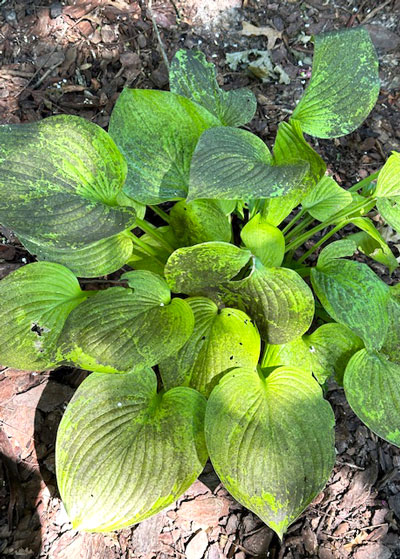
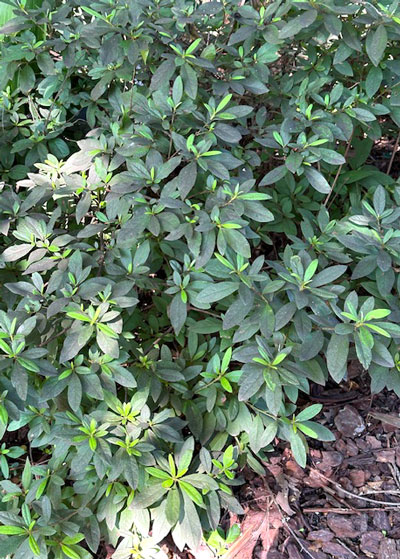
Answer: It’s a fungus known as “sooty mold.” (Appropriate name, because it looks like the plants were next to a smoky fireplace.) Other than shading the plants, the mold is harmless. Of course, it’s also incredibly ugly. You can wash it off with a couple of sponges and warm, soapy water. Power washing would work on harder surfaces, but not on hosta leaves and probably not on azaleas unless you were extremely careful. Try a very small area first. If all else fails, just wait until next year. New leaves will replace the old foliage and all will be well. For the record, this has been an unusually heavy year for bark scale. I’m also seeing aphid populations starting to build on crape myrtles. They, too, can result in honeydew drippage. It gives rise to the mold. I’ve had good luck with the Imidacloprid drenches. I suspect you have identified your problem correctly. Be sure to follow directions carefully as to amounts.
QUESTION 3
WHAT IS THE SECRET TO ELIMINATING BERMUDAGRASS FROM MY ROSE BEDS?
Question: What is the secret to eliminating bermudagrass from my rose beds? I’ve put a barrier down, added mulch, and it still comes back with deep roots. Carol B., Forney.
Answer: It’s very difficult to get rid of bermudagrass with mulches and mats. I’ve had excellent results spot-treating it with a glyphosate-only herbicide such as the original Round Up or one of its clones. They were developed to kill grasses on contact. They are not active in the soil so there is no chance of contamination. You can apply them with a trigger bottle. Wrap the trunks of your roses with aluminum foil while you’re spraying, and you’ll have no cause to worry about hurting the roses. They will kill all the bermuda within one week. If any seedlings sprout up in successive years all you have to do is spritz them with a little spray of the same material. Just be sure you get a product that contains only glyphosate – no other active herbicidal ingredient.
QUESTION 4
WHAT EVERGREEN TREE MAKES A GOOD PRIVACY SCREEN?
Question: After years of issues with Leyland cypress, we are looking for another evergreen tree for a privacy screen. We are happy with our Eagleston hollies. Do you have any other recommendations for our area? Kevin O., McKinney.
Answer: I do! My wife and I also live in the McKinney area, so I’m very familiar with the growing conditions. The native eastern redcedar (Juniperus virginiana) is the ideal replacement for Leyland cypress. Same size. Same growth form. Far more durable. You’ll see them in use in commercial landscapes all across McKinney. Your lovely landscape is large, but you wouldn’t want to use more than one or three – they grow to be 30 to 35 ft. tall and 30 ft. wide. If you want a broadleafed plant, one of the compact forms of southern magnolia such as Little Gem or D.D. Blanchard would be nice. They, too, will get fairly large, however. As for hollies, my choice by miles would be Nellie R. Stevens holly. Eagleston is lovely, but it’s not a good long-term choice for the Blackland alkaline clays of Collin County. Yours look terrific, but the plant often develops iron deficiency after 6 to 10 years like the other American holly hybrids do. Nellie R. Stevens grows to 18 to 20 ft. tall and 10 to 14 ft. wide if never pruned. It holds its dark green color and produces very large red berries. I cropped your photos after I wrote my reply, and having studied them closely, Nellie R. Stevens might be my preferred suggestion.
Please permit one other unrelated note. If any of your turf happens to be St. Augustine, particularly that in the foreground in the more distant photo, you might want to check for chinch bugs. That browning is how their damage shows up at the outset. They can do serious damage in a hurry.
QUESTION 5
WILL GROUNDCOVER AFFECT LARGE RED OAK TREES OR YUCCAS?
Question: I have a large bed with trees, yuccas, and groundcover. Will the groundcover affect any of the large red oaks or yuccas? Lance Q., Denton.
Answer: I seriously doubt it. Without knowing what groundcover you have, the only impact I can think of would be if it was robust enough to clamber up, into, and over the yucca plants. But that could be avoided by careful trimming. As for competing for water and nutrients, there should be plenty to go around.
QUESTION 6
WHY THE DIFFERENCE IN SOME OF MY MEXICAN PETUNIAS? HOW CAN I HELP THE SMALLER ONES?
Question: I planted two beds of Mexican petunias (Ruellias) two years ago. Some plants are nice and full, and others are smaller with yellowish leaves. All the plants receive the same sun and water. Why would there be a difference? How can I help the smaller plants? Jim C., Tomball.

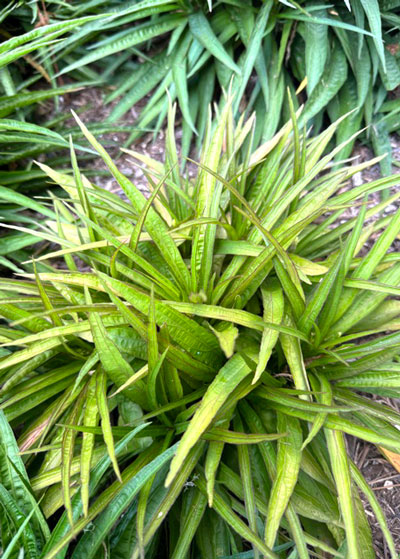
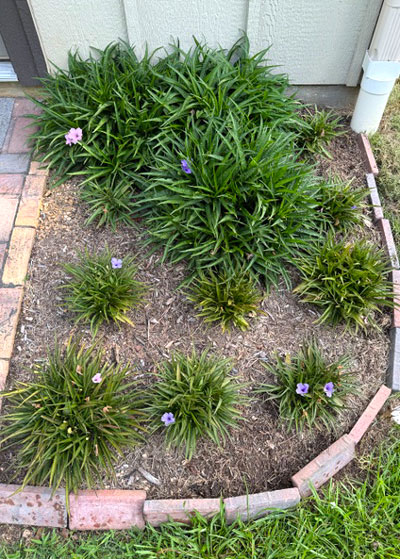
Answer: I always seem to get one question that makes me go “Hmm,” and yours is the one this week, Jim. I can’t tell from the closeup of the foliage if there is anything going on there. It certainly doesn’t look right, but I’ve never experienced spider mites (or any other pest) on my Mexican petunias. I would suggest thumping a couple of the leaves over a sheet of clean white paper to see if any nearly microscopic pests start to move about freely. If so, those would be the mites and a general-purpose insecticide labeled for mite control should help. But I’m not sure they are there, so do check closely.
Otherwise, there might be a difference in the soil beneath the affected plants. Perhaps even in the soil in which they were growing in their original pots. I would dig one of the plants up and examine its roots for any signs of abnormalities, either of the soil and its contents or of the roots (for example, nematode galls). It could be time, this fall, to dig up the entire bed(s), separate the healthy plants into clumps and replant from the vigorous sections to see if you can get them to cover.
(Hope you and your gardens came through the storm this week in relatively good shape. We were all pulling for our friends and fellow Texans! Same well-wishes to Maxine, above.)
QUESTION 7
WHAT SHOULD WE DO WITH OUR RISING SUN REDBUD?
Question: Our beautiful Rising Sun redbud broke off at the trunk in the last windstorm. After that we were planning on planting a new tree in the fall, but a re-sprout popped out. Will this eventually grow back as a tree, or will it become a strange looking shrub? Karla M., Anna.
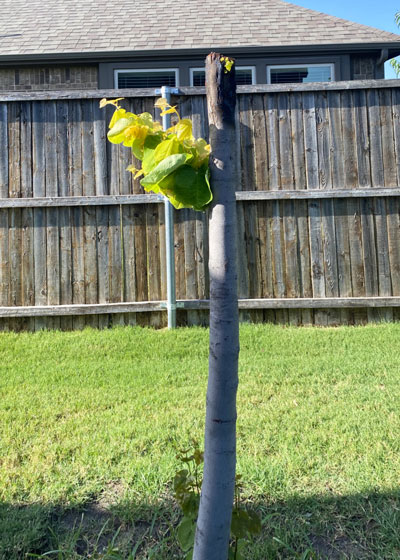
Answer: This is your call. However, if you decide to leave it, you’ll need to make a fresh cut just above the new sprout. There is a good chance that the stump left behind after that cut could decay back to the side sprout, so my inclination would be to bite the bullet and buy a new tree for a fresh start. This wouldn’t look like a strange shrub, but it would certainly look like an unusual tree for several years if you tried to retrain it.

